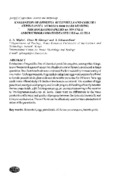| dc.contributor.author | Migiro, L. N. | |
| dc.contributor.author | Gitonga, L. M. | |
| dc.contributor.author | Sithanantham, S. | |
| dc.date.accessioned | 2024-04-24T05:56:20Z | |
| dc.date.available | 2024-04-24T05:56:20Z | |
| dc.date.issued | 2008-01-16 | |
| dc.identifier.citation | Journal of Agriculture, Science and Technology / Vol. 9 No. 1 | en_US |
| dc.identifier.issn | 1561-7645 | |
| dc.identifier.uri | DOI: 10.4314/jagst.v9i1.31733 | |
| dc.identifier.uri | https://karuspace.karu.ac.ke/handle/20.500.12092/3087 | |
| dc.description | Main article | en_US |
| dc.description.abstract | Production of vegetables free of chemical pesticides requires, among other things, use of biocontrol agents that can be effectively and efficiently produced in large quantities. Two factitious hosts were evaluated for their suitability in mass rearing of two native Trichogrammatids. Egg cards bearing host eggs were separately offered to female parasitoids in glass vials and allowed to parasitise for 24 hours. New egg cards were offered daily till death of the female parasitoid. The number of eggs parasitised, emerged adult progeny and female progeny differed significantly between the two parasitoids, with Trichogramma sp. nr. Mwanzai appearing to be superior to Trichogrammatoidea sp. nr. lutea.There were no differences in the mass production efficiency and quality of progeny between the Ephestia kuehniella and Corcyra cephalonica. The two hosts can be effectively used for mass production of either of the parasitoids. | en_US |
| dc.description.sponsorship | Sida | en_US |
| dc.language.iso | en | en_US |
| dc.subject | Egg-parasitoids | en_US |
| dc.subject | biocontrol | en_US |
| dc.subject | Helicoverpa armigera | en_US |
| dc.subject | tomato pests | en_US |
| dc.title | Evaluation of Ephestia kuehniella and Corcyra cephalonica as hosts for mass rearing trichogramma species nr. Mwanzai and trichogrammatoidea species nr. Lutea | en_US |
| dc.type | Article | en_US |
